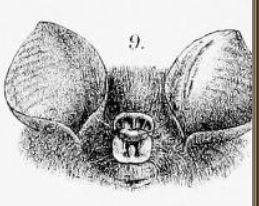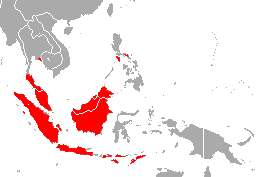Bicolored roundleaf bat facts for kids
Quick facts for kids Bicolored roundleaf bat |
|
|---|---|
 |
|
| Conservation status | |
| Scientific classification | |
| Genus: |
Hipposideros
|
| Species: |
bicolor
|
 |
|
| Bicolored roundleaf bat range | |
| Synonyms | |
|
|
The bicolored roundleaf bat (Hipposideros bicolor) is a cool bat found in parts of Asia. You can find it in countries like Indonesia, Malaysia, Singapore, the Philippines, Thailand, and Timor-Leste. These bats live in dark places like caves, rock cracks, and tunnels. They like areas with lowland forests. They often live in large groups. These bats mainly eat small flying insects.
They use a special skill called echolocation to find their way around and hunt. It's like having built-in sonar! They send out ultrasonic shouts from their nose. This helps them understand their surroundings. Echolocation also helps them tell other animals apart. They can even guess what kind of animal it is by its wingbeats and size.
The color of their fur can change. It depends on where they live. If they live in a cave with strong fumes, their fur might turn orange. But if they live in a well-aired spot, their fur will be light brown.
Contents
About This Bat's Name
A Dutch scientist named Coenraad Jacob Temminck first described this bat in 1834. He gave it the scientific name Rhinolophus bicolor at that time. Later, scientists moved it to a different group, Hipposideros.
There are four types, or subspecies, of the bicolored roundleaf bat:
- Hipposideros bicolor atrox
- Hipposideros bicolor major
- Hipposideros bicolor bicolor
- Hipposideros bicolor erigens
Bat Biology and Echolocation
Scientists have studied bicolored roundleaf bats in West Malaysia. They found two different groups that look very similar. But these groups have some key differences. They differ in their size and how they use echolocation.
The first group has rounder wingtips. These bats are lighter and have shorter, wider wings. Their echolocation calls are between 127.0 and 134.4 kilohertz.
The second group has shorter lower leg bones (tibias). But these bats weigh more and have larger wings. Their echolocation calls are higher, from 138.0 to 144.0 kilohertz.
Researchers think the first group's body shape helps them fly better. It might make them more agile. This could help them hunt in places with lots of trees or obstacles.
Where These Bats Live
The bicolored roundleaf bat lives across Southeast Asia. Its home range includes Indonesia, Malaysia, Singapore, the Philippines, Thailand, and Timor-Leste. These bats can be found at heights up to about 600 meters (2,000 feet) above sea level.
Each subspecies lives in a different area:
- Hipposideros bicolor atrox lives from southern Thailand to Sumatra.
- Hipposideros bicolor major is found on the Enggano Islands and Nias.
- Hipposideros bicolor bicolor lives in Java and stretches to the Lesser Sunda Islands and Borneo.
- Hipposideros bicolor erigens lives only in the Philippines.
Their Home Environment
Bicolored roundleaf bats like to live in groups. Sometimes, up to 150 bats will roost together. They need dark places with high humidity. They also prefer places where the temperature stays cool. This means their roosting spots are often cooler than the air outside.
These bats prefer to live in forests. They will not stay in areas that humans have changed or damaged.
Threats and How We Protect Them
As of 2020, experts say the bicolored roundleaf bat is a least-concern species. This is the lowest level of worry for a species. It means they are not currently in danger of disappearing. They are found over a wide area. Their homes include protected areas. Also, they are quite common in many places.
However, these bats are very sensitive to losing their homes. This happens when forests are cut down. Forests are being cleared quickly for new homes and farms. A big reason is the demand for palm oil. Palm oil comes from oil palm trees. It is used in many products like soap, lipstick, and margarine. Malaysia and Indonesia produce most of the world's palm oil.
Organizations like the WWF are working to help. They team up with big companies that use palm oil. They want these companies to agree to only use palm oil from land that has not been deforested. This helps protect the bats' homes.


